Horror games have one simple purpose: scaring you. They’re fuelled by long moments of tension which erupt in a brief explosion of fright, before it recedes and the terror sets in again. My favourite horror game ever, 2010’s Alan Wake, does things differently. It throws fright out the window, gives you every gun imaginable, and uses that to deliver one of the best moments in horror game history.
Most horror stories work like this: the audience knows something bad is going to happen, the feeling builds, and then it climaxes. Terror is the emotion you experience that leads up to horror. It’s the moments when you know something bad is about to happen, that feeling of growing dread. Horror is the moment when the terror is released. It’s that feeling you get when you see something frightening and disgusting. Horror is what you feel when you see Johnny Depp’s murder in A Nightmare on Elm Street or the infamous chestburster scene in Alien. How this plays out in Alan Wake, however, is a bit different.
Alan Wake is a novelist who suffers from writer’s block. His wife, Alice, takes him on a vacation to the scenic northwest United States. Unfortunately, their vacation spot, Cauldron Lake, is home to a malevolent force that is powered by human imagination. This force kidnaps Alice and forces him to write a story where it gains power. Alan fights back, inserting himself into the story, hoping to defeat the darkness and rescue Alice. This is where the game begins.
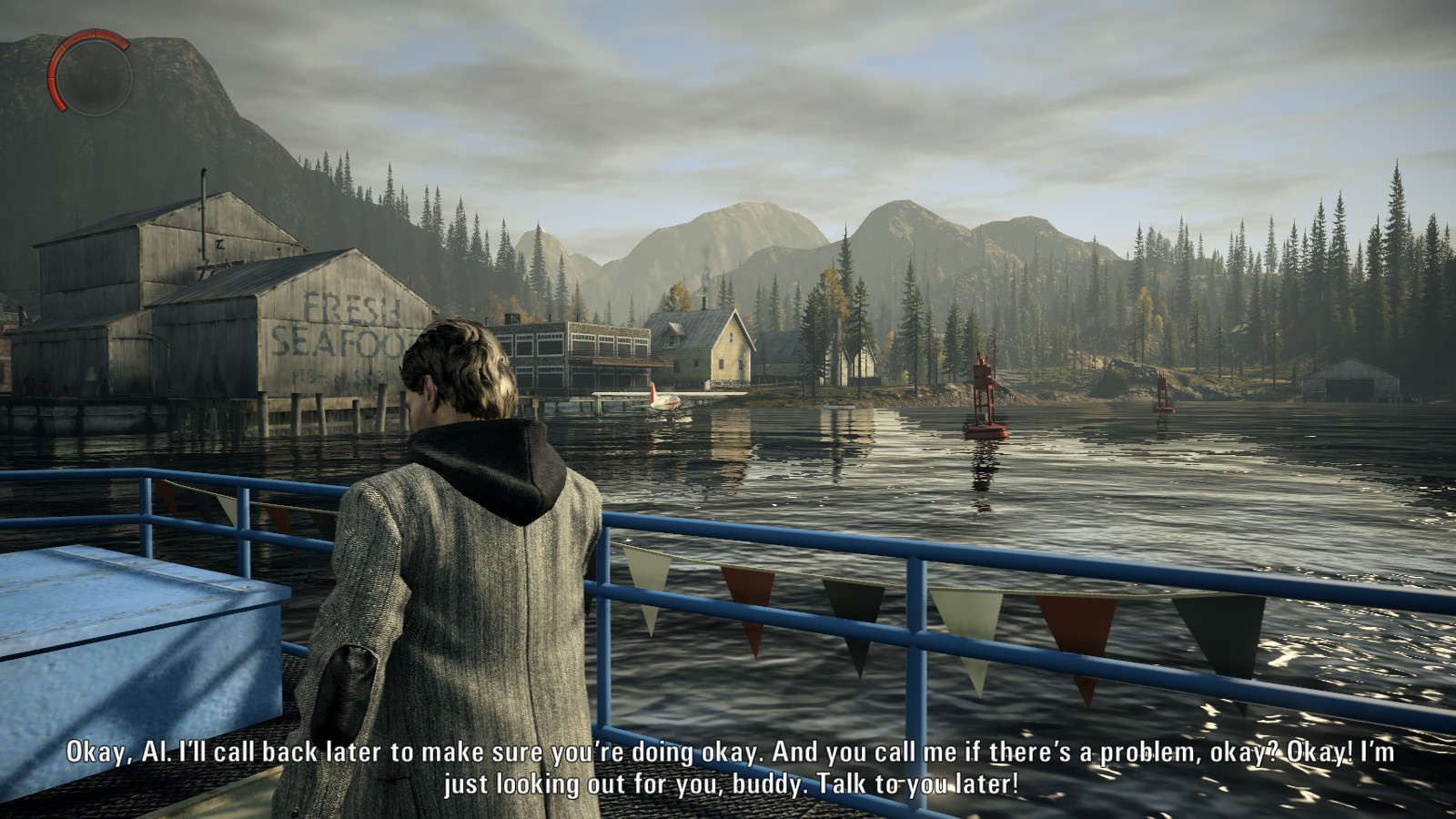
This conceit is part of what makes Alan Wake so special. Most horror games I’ve tried play things straight: you’re the protagonist, scary monsters are running amok, and you have to deal with them in some way. Alan Wake, which was created by the Finnish studio Remedy, adds another layer of uncertainty. Is Alan crazy? Is any of this real? He insists his wife died at a lodge on a lake, but everyone he speaks to says the town sank into the lake years ago. The only person who seems to indulge his fantasy is Mott, a character who claims to have kidnapped Alan’s wife. He demands Alan exchange his story in exchange for Alice, but, just before he dies, ripped apart by a tornado summoned by the dark presence, confesses that he doesn’t have Alice. He never did.
Then we begin the game’s fourth level, an excellent chapter called The Truth, which will end up with us rocking our hearts out in front of a mob of angry monsters. It showcases the game’s distinct and very successful approach to horror.
Alan wakes to the sound of Dr. Emil Hartman’s voice. The doctor claims to be treating Alan’s writer’s block, which was caused by Alice’s death years prior. Hartman has been treating Alan, but Alan has been a stubborn patient. The two go on a walk together, as Hartman explains how the writing process works. Alan expresses some doubt at first, but the story sounds far more plausible than anything about shadowy figures and malevolent forces.
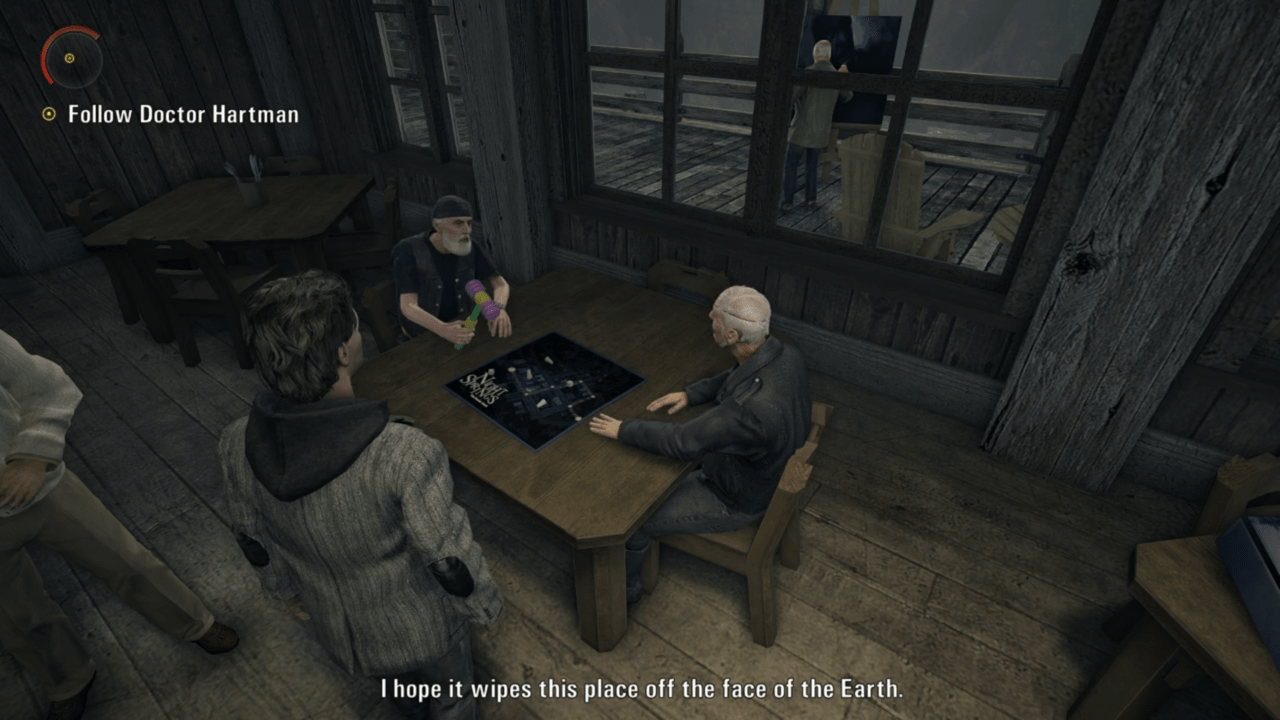
As they walk through the lodge, Hartman introduces Alan to other creative people who’ve been struggling to produce art. There’s a video game programmer building a fort. A painter sits on the balcony. Alan’s scepticism resurfaces. The artist used to paint landscapes, but he is now happier painting dark, twisted images clearly influenced by the dark presence.
What’s great is that here, in this horror game, we’re walking around a brightly-lit lodge talking to mental patients. The previous level offered almost an hour of intense solitude, with Alan facing some of the toughest encounters up to that point in the game. Now, in the lodge, Alan faces no monsters, blood, or gore. Everything is just fine, except for the Anderson brothers, Tor and Odin, old rockers from the 70s, who are being treated alongside Alan. They insist that Alan isn’t crazy, that he needs to escape the lodge and travel to their farm, where they have a secret message for him. The two also confuse him with Tom Zane, an old poet whose name shows up occasionally throughout the game.
Unfortunately, there isn’t much Alan can do to escape his predicament. A storm brews, Alan is ushered back to his room, and the staff insists he write. He cooperates until the Andersons attack one of the nurses and lock away a guard. This gives Alan a chance to escape, where he discovers his agent, Barry, who’s been kidnapped by Hartman and his staff. As it turns out, Hartman, a servant of the Dark Presence, had been gaslighting Alan, getting the writer to doubt his own memories in order to force him to continue his story.
What follows is a mad dash out of the lodge and through a hedge maze to Barry, who’s found a car. It’s an homage to The Shining. At a distance, the lodge is a clear imitation of the one seen in Stanley Kubrick’s adaptation of the Stephen King novel, and the hedge maze escape takes its cues from the film.
Remedy’s combat design really shines in the hedge maze and helps advance the game’s unusual approach to horror. It’s a pure combat gauntlet, with frequent ambushes. Once the player passes through the maze, they wind their way through a garden, facing off against a tough mini-boss before tackling some of the biggest fights and toughest enemies the game has had up to this point.
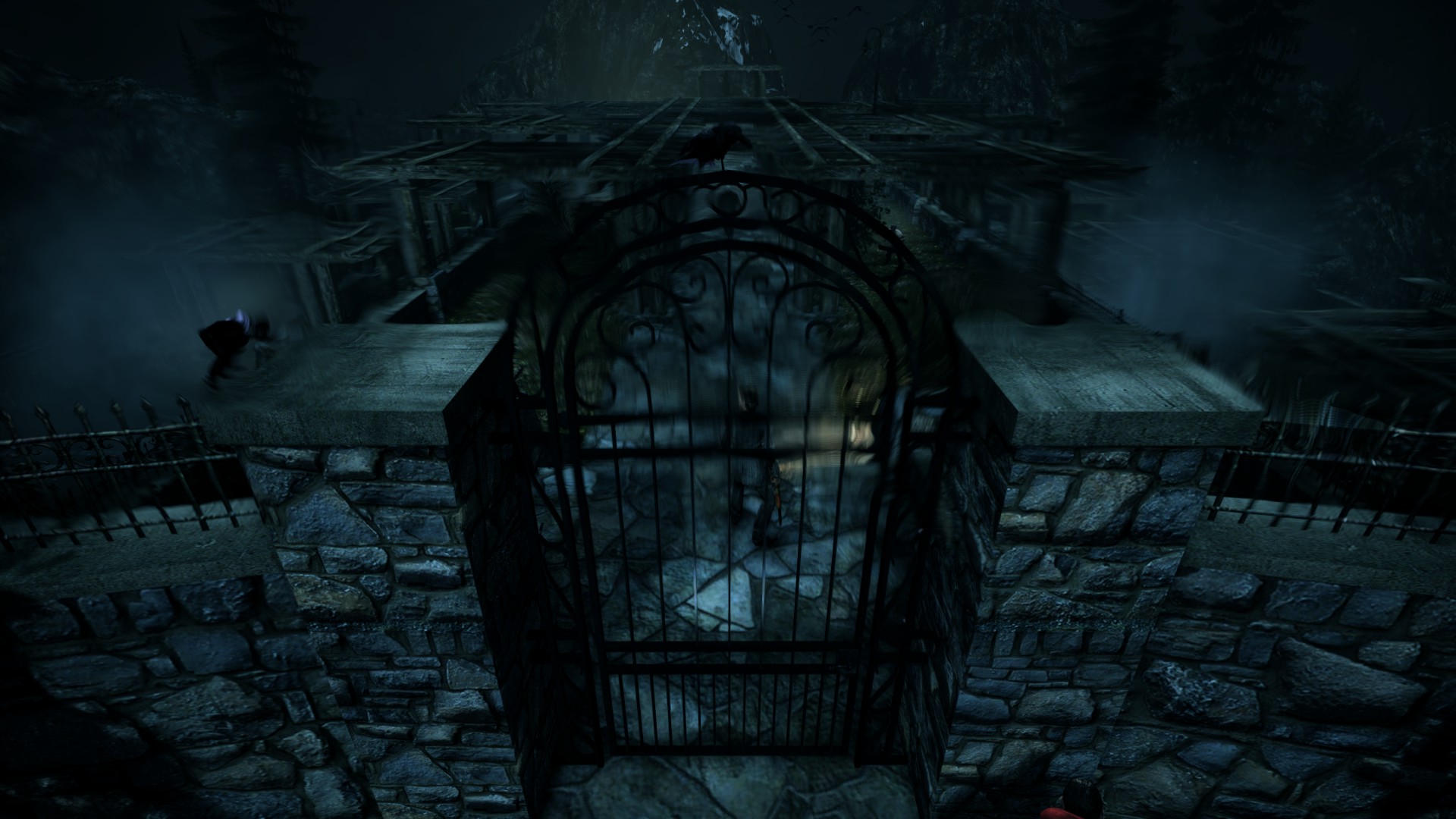
Alan Wake‘s combat system is unusual, which, like any non-standard combat system, means it’s divisive. In a traditional third person shooter, like Remedy’s previous Max Payne games, you shoot at something and it dies. Because Alan Wake pits you against the forces of the darkness, light is an important part of your arsenal.
The basic rhythm of Alan Wake goes something like this: half a dozen enemies show up, so-called Taken who are cloaked in darkness, some wielding chainsaws or axes. You can’t damage them with your pistol, hunting rifle, or shotgun until you burn away this darkness, so you move your flashlight from enemy to enemy as they advance on you, burning away their shields. Then you can kill them.
Some people aren’t wild about this: the act of burning away the darkness before you can do damage can feel tedious if you’re used to other games, but Remedy is doing this for a reason, which is tension. Shooting can get mindless if all you have to do is pull the trigger.
Most of the enemies in Alan Wake are melee fighters. They want to get up close and hit you. You have to keep them at range. Because they’re afraid of the light, shining a flashlight of them will slow them down or cause them to retreat. Unfortunately, shining a light at one enemy means you’re focused on him, which allows any of his friends to sneak up behind you. In any given encounter, you’re constantly juggling enemies.
If there was no shield to use on the enemies, you could simply shoot one enemy, then tackle the next, and so on and so forth. Because of the dark shield mechanic, you have to remain on the move, burning away the darkness, switching enemies frequently to ensure no one gets too close. Managing so many enemies gets tense, especially because you’re dealing with two ammo pools, batteries for your flashlights and bullets for your guns .
When you have a gun and you can kill whatever you are shooting at, shooting becomes fun, not scary. Alan Wake‘s shield mechanic creates scenarios where you’re standing there, gun pointed, as enemies slowly advance on you, while you desperately pray you’ll be able to use your gun before they get to you.
It can get a little monotonous, however, because the formula is so often the same: burn the shield, manage enemies, shoot gun. What does Remedy do? They give you some cool tools. First, there’s the flare: when you light it, the enemies who are trying to melee you back up. The light hurts them. They can’t attack. It gives you breathing room, but doesn’t last long — as soon as it’s gone, the enemies approach again, knives, axes, and chainsaws at the ready. I don’t think I’ve ever seen a tool like this in a game: creating a field that gives you breathing room is a really cool power, and I’d like to see people rip it off. The closest thing I can think of is the relic bubble in Destiny‘s Vault of Glass raid, and even that doesn’t really do justice to Alan’s flares.
It wouldn’t make sense for a novelist to have, say, a rocket launcher or a grenade, so Remedy gives Alan a flare gun and flashbangs. The searing red light of the flare gun works like a rocket launcher on a mechanical level, shoot it, watch it detonate, boom, the bad guys die. Toss a flashbang, and the harsh burst of light dispatches your shadowy foes, leaving you unharmed. It’s a creative way to approach traditional video game weaponry.
You also have a dodge mechanic. Hit the sprint button in any direction, and Alan will dodge, often narrowly avoiding an attack from the Taken. Dodge mechanics are hard to get right, but Remedy, the pioneers of bullet time in games, pull off dodges spectacularly. Every dodge in Alan Wake feels satisfying thanks to the great feedback as time slows down and the enemy’s attack goes whooshing by.
Combat in Alan Wake is a love-hate thing. You either take full advantage of the tools at your disposal and find variety in the ways you use them, or you tackle every fight the exact same way and tire of it quickly. It’s going to come down to how creatively you want to play. I find the fight through the hedge maze to Barry some of the best combat in the game; you’ve got every weapon at your disposal, and you can use all of them to great effect. Launching a flare through a murder of evil crows always excites me.
The last encounter at the lodge is one of my favourites. Alan finally catches up to Barry, who sheepishly admits that he had panicked and slammed the gate shut, dropping the key. He promises to look for it. One of gaming’s most common tropes is locking the player in a room until they have killed all the bad guys, and that’s exactly what happens here. .
It’s a humorous moment that manages to characterise Barry and Alan, and it’s also the hardest encounter in the level up to this point. Any other horror game would have made it a moment of anxiety and desperation. Not Alan Wake.
When the fight’s over, you escape with Barry, drive down the road, discuss the cardboard cutout of Alan in the back of the car — Barry stole it from a creepy stalker of Alan — and eventually crash. The crash splits up Barry and Alan. For the first time, Barry is out in the woods on his own. It’s a great way to craft tension. You, as Alan, have barely survived some of the encounters in the game, but Barry? Fat, cautious Barry? How will he survive?
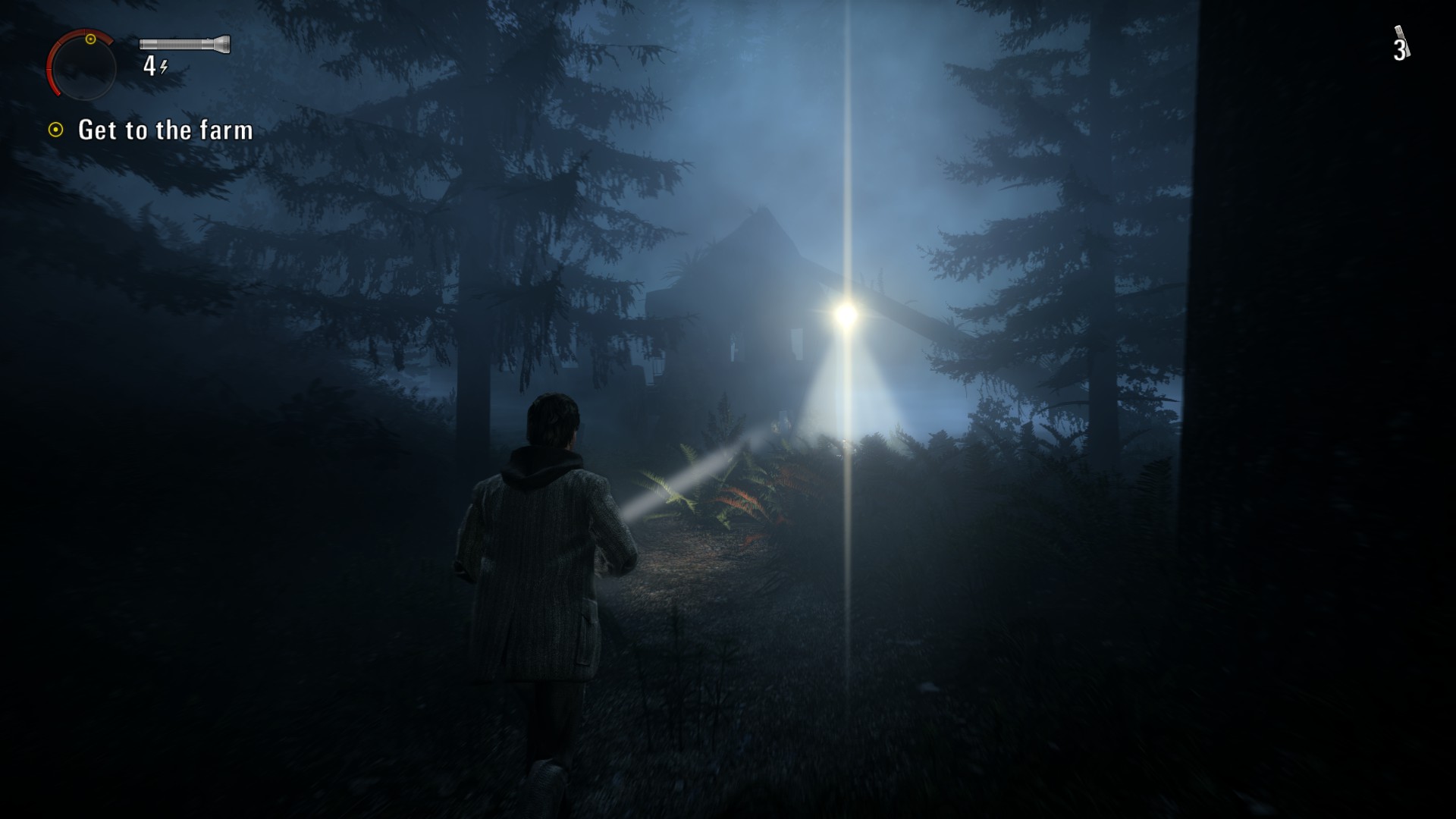
Alan can’t see Barry, and there’s a cliff separating the pair, so they agree to meet up at the Anderson farm, which they can see off in the distance. Here, the map really opens up; there’s a firewatch facility to climb, abandoned buildings with extra flares and ammo, even cars to drive. Headlights are a great way to combat the darkness. The Taken can pop up anywhere on the map, too.
Originally, Alan Wake was supposed to be an open world game, and it shows. We normally play horror games in small, enclosed spaces like crumbling castles and abandoned spaceships. Alan Wake is set in massive forests, its levels more like the ones found in Crysis than those in Alien: Isolation or Amnesia.
Yet again, Alan Wake subverts our expectations: it fuels our fear by dwarfing us! The maps are big, and Alan is small. He’s often in a hurry. In one level, he has to get to the kidnapper by a certain time. In The Truth, Alan is trying to reach Barry before something bad happens. The size of the level — the fact that you can take whatever route you want to get to Barry — is paralyzing. Should you rush directly to him? Where will the Taken come from? Would exploration provide you with better gear when you do find him? The root of good horror is the unknown, and the size of Alan’s levels introduces an awful lot of unknowns.
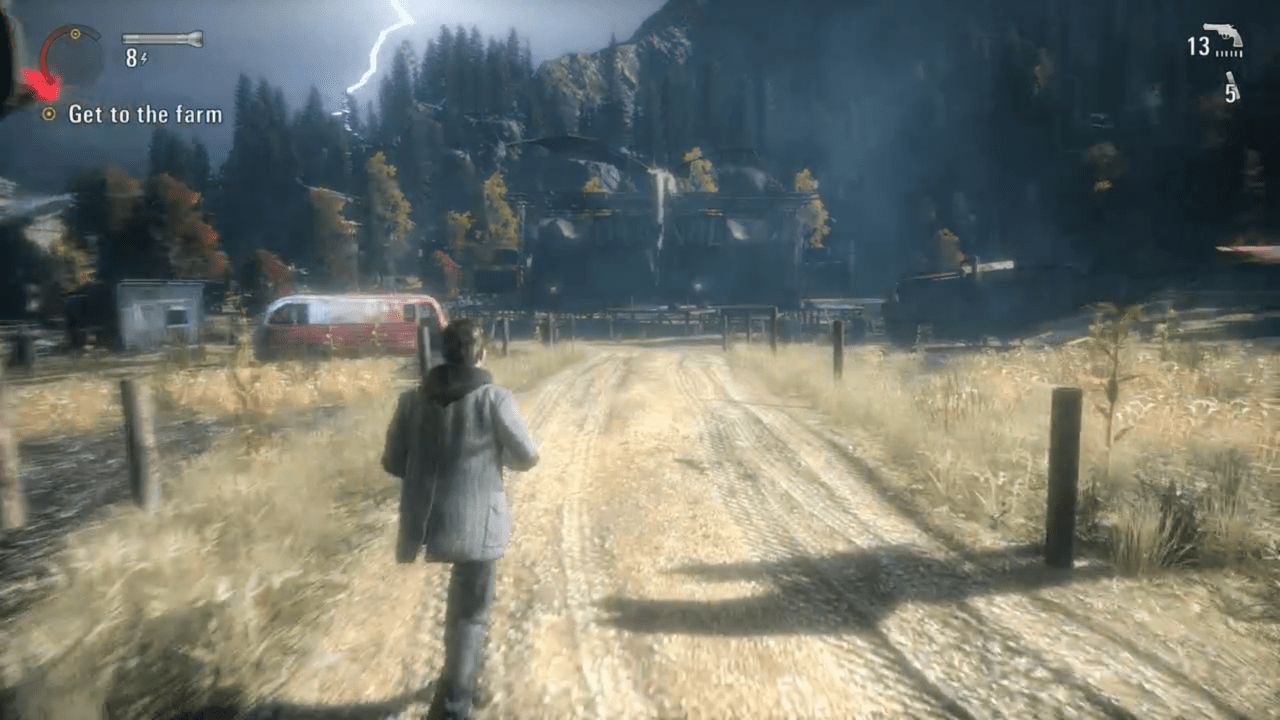
You eventually reunite with Barry… on a stage. The Anderson brothers used to be rockers, members of the band “The Old Gods of Asgard,” so they built a stadium on their farm, adorned with viking memorabilia and pyrotechnics… lots of pyrotechnics.
Up to this point, you’ve gone from the lodge, where you couldn’t do much aside from talk to people, to the hedge maze, which has some of the narrowest corridors in the game, to a massive, open map that is so big it’s disorienting, with the only real goal being to “find Barry.” When you do, he’s there, on this incredible stage, and you know something wonderful is about to happen.
You are going to kill a crap ton of monsters up on that stage.
Remedy has worked closely with Finnish band Poets of the Fall in previous games, but for me, their best collaboration is here. I’ve seen bad attempts at original pop music and good use of licensed songs in other games, but Children of the Elder God, the song that plays as you hold off hordes of the darkness with a pyrotechnic show, was written precisely for this fight. The lyrics are about the fight against the Dark Presence, with references to the mythology surrounding the Anderson brothers’ names, like “Memory and Thought,” the name of Odin’s two ravens in Norse mythology. It’s not often that a custom rock song works so seamlessly with a game’s narrative, but it works fantastically here.
The song’s themes tie closely with the narrative of the game, but the song itself is the right kind of fist-pumping, head-banging rock you need when going up against the Taken. They swarm the stage, but the lights burn away the darkness from many of the enemies, making it easy to dispatch them.
As an encounter goes, you stand on the stage, and enemies rush at you. There’s no cover to encourage strafing, and you don’t need to manage enemies as much. Looking at it purely in terms of level or encounter design, it’s nothing special. When the animatronic dragon opens its mouth and the lights switch on, enter the pool of light and heal. Keep enemies at bay. Repeat. Nothing to it.
This moment is incredible not because of the specifics of the encounter, but because of the context. In the best stories, tension doesn’t always lead to the same result: one of the best moments in Ridley Scott’s Alien is an incredibly tense hunt for the titular Alien, only to be surprised — and relieved — by Jonesy the cat. Here, we end an escape from an asylum at an impromptu demonic rock concert. This is why Alan Wake works.
Of all the video game genres, horror is unique because it’s about emotion. “Role-playing game” is not an emotion. “First-person shooter” is not an emotion. Puzzle, sports, strategy, action-adventure, you name it: these genres are tied to mechanics. Horror is different, because everything in the game, from mechanics to aesthetics, is all about crafting emotion within the audience. This leads to some of the best, most emotionally resonant games I’ve ever played. Unfortunately, some games assume horror, and its constant companion, terror, are the only emotions.
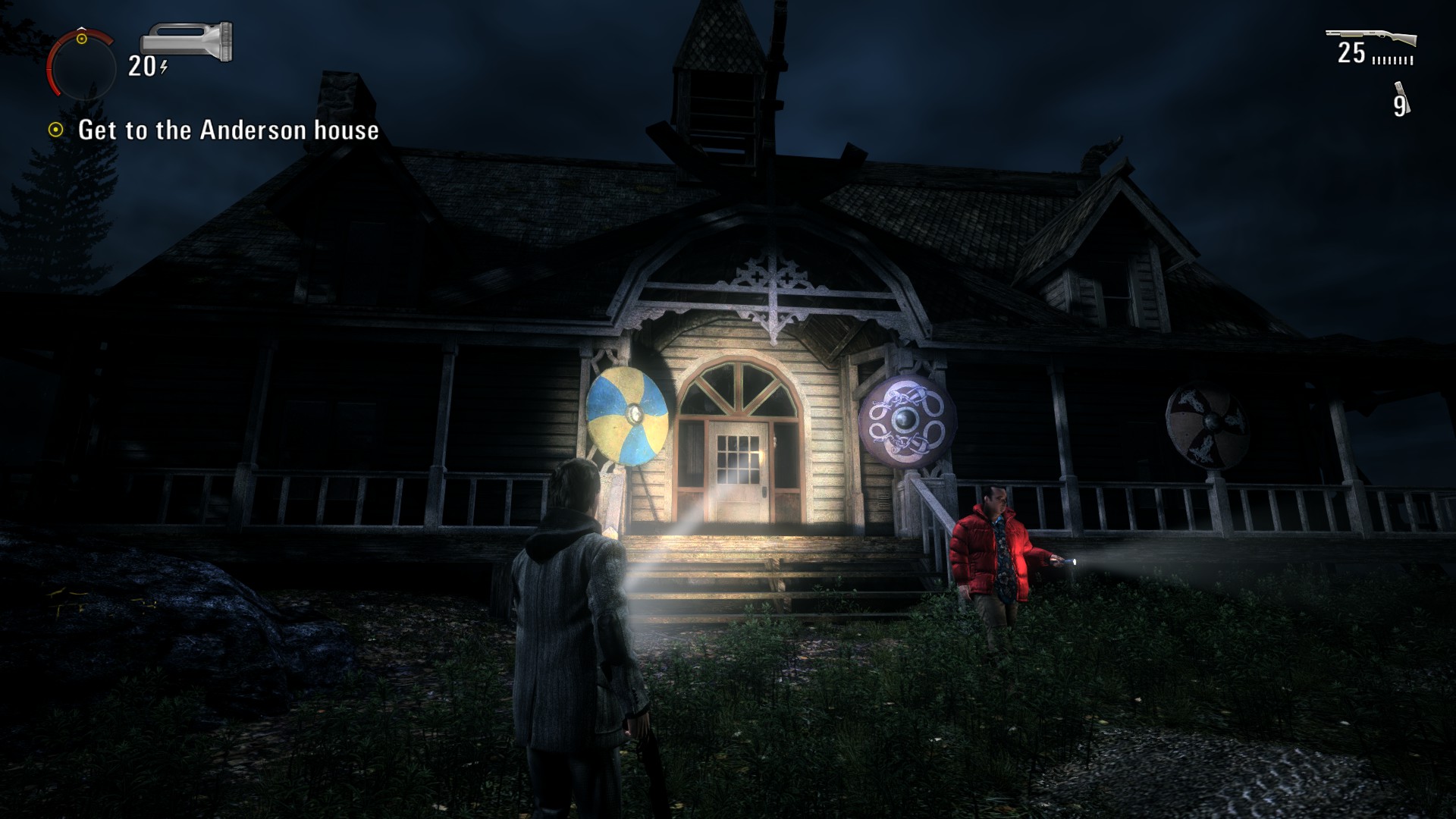
Most of the horror games I’ve played tend to build up tension and release it with an encounter against something scary. I’ve enjoyed playing The Evil Within, but while the encounters are different, the emotions remain the same: terror and horror. Whether you’re fighting hordes of enemies or just running away from one, the emotions occupy a single spectrum. The same is true for Alien: Isolation. I feel terror when I’m expecting something bad to happen and am horrified when I confront that thing. It’s important to confront these feelings, but limiting a game to them can be wearisome.
Alan Wake works because it features a broader emotional spectrum. It begins after hours of loneliness. You get the nice, quiet downtime of an asylum. Next, you’re in for some pure combat. Barry provides the occasional joke — whether it’s about Alan’s cardboard cutout or how he lost the key to the gate — releasing some of the pressure the game’s built up, but it’s the stage battle that finally lets you blow off the steam you’ve been building throughout the level.
Horror can’t work in a vacuum. If The Truth had been nothing but constant tension, with no relief, no humour, and no moments of empowerment, would it have meant anything? Remedy doesn’t seem to think so. As a result, Alan Wake surprises and delights just as easily as it terrorizes. It uses these feelings to give a power to its horror that other games simply can’t match. That’s why a rock concert can make a horror game so memorable.
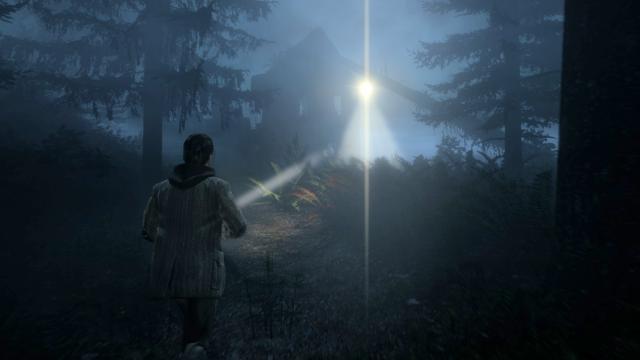
Comments
21 responses to “The Level That Proves How Special Alan Wake Was”
Ha ha! Yeah, Alan Wake was pretty ‘special’.
Seriously though, it was a pretty fun but average title. I enjoyed my playthrough but felt no reason to ever play again.
Too much run & gun, not enough horror for me.
Loved the asylum bit with Thor & Odin, great bit.
Agreed. Loved the concept, but found the combat far too frequent and repetitive. I also had no desire to return to it after I finished. Still, I think its existence is important, and encourages other developers to try something different. The story itself was excellent.
Yeah, it was nice for the Max Payne guys to attempt something new, the story certainly was. It just played a bit too similarly.
Lol, kinda dismissed the entire article, there, didn’tcha? 😉
Ayup
I reckon this game is a gem that didn’t get nearly enough of the praise it deserved, Quantum Break looks like it’s gonna kick ass
Alan Wake us the reason I’m interested in Quantum Break which is one of the reasons I got an xbone.
It was the last great 360 exclusive (well you can get it on PC now too)
I agree, I loved alan wake and consider it one of my favourite story/narrative games.
The combat ruined this for me. I find it frustrating and an annoyance, which is a shame because the rest of the game is pretty cool. I’ve put it down quite early on and due to the combat I have no intention of going any further. If I could bypass the combat scenes…..
I loved Alan Wake. Story was a bit nutty by the end but captured my attention all the way through.
Alan wake was great. I picked up a copy in JB right after I got an xbox because it looked interesting and it was great. One of the best games out there but extremely underrated.
This was a good game, but it suffered from some of the worst carrot-dangling and goalpost-moving. Plus they emptied your inventory after every single chapter, very annoying.
Great article and I agree with everything you’ve said but as others said above, I never felt compelled to do a second play through.
loved alan wake. I thought the beginning was well done, was peaceful and let you get absorbed into the location a bit before it all went to hell.
I don’t think it went to really scare you but make horror scenes intense and uncomfortable 🙂 The gunplay didn’t bother me, i thought it was different and fun.
The story, characters and location sold the game though
i really tried to like this game but it just didnt grab me. odd because i like games like silent hill 2
Alan Wake was a real rough diamond. The episodes felt a little long and the combat was a bit too frequent, but it was really worth the time.
It still amazes me how many people mistake the intentionally bad writing as simply bad writing. Good satire is very hard to do well and Alan Wake is one of the best examples of doing it so well that people don’t click that it’s meant to be this way. Somehow this game manages to be a great horror game and still satirise film and TV horror and suspense, self indulgent writers, and awful writing in horror games.
My main memory of AW was my hatred of the mini map and constant checkpoint interface telling me exactly where to go and don’t worry there is nothing at stake
Alan Wake was a pile of shit.
Nothing like what it was supposed to be.
Was stuck in development hell and stripped of features.
Rubbish article from clueless writer.
Ok mr angry. It’s an opinion piece. Relax. I didn’t like Alan wake very much either.
i can’t help it, I fell for the hype years ago :/
Alan Wake was the first game I never finished. Bought it new on release day, played through a few missions, then set it aside and never went back to it. I disliked the combat, and I disliked the story. There was never any question of uncertainty; is Alan Wake crazy and everything his delusion? No, obviously not, there’s some weird non-descript supernatural evil afflicting him and the town. But they never wanted to explain what that was. Also I found the collectibles (I think they were pages from his novel?) too hard to find.